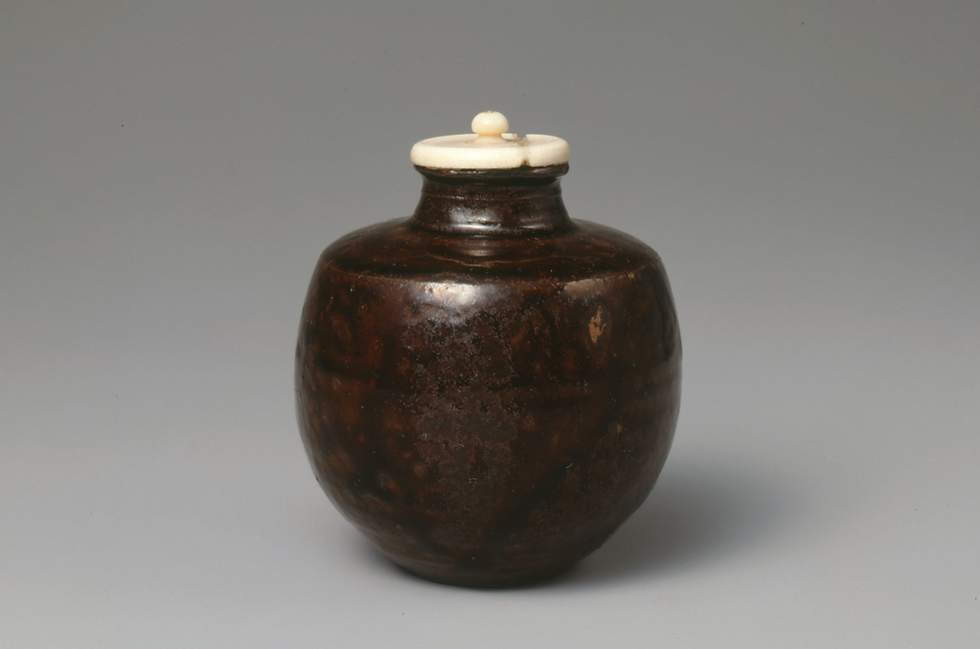茶入筆記 vol.38 福岡美術館:神屋宗湛、黑田長政,唐物茶入 銘 「博多文琳」 ,黑田家秘藏之神品 - Fukuoka Museum, Karamono Chaire Hakata Bunri, Heirloom by Kamiyasu Sōtan and Kuroda Nagamasa
- SACA

- Jun 2
- 3 min read

此器原為博多著名豪商神屋宗湛(1551–1635)之所藏。據傳,宗湛曾多次婉拒豐臣秀吉與福岡藩初代藩主黑田長政之所請,堅不割愛。
直至黑田家第二代藩主黑田忠之登台,宗湛最終以此茶入易得金二千兩與知行五百石,奉為貢品。其後本器長期秘藏於黑田家,並附有五組仕服與牙蓋,足見其珍視程度與作為茶道具名器之地位,實為權勢階層垂涎之物,世代珍藏,歷數百年而不外傳者。

唐物茶入 銘「博多文琳」
中國.宋代
陶器
高 6.4 公分,胴徑 6.4 公分,底徑 3.3 公分
福岡市美術館 黑田資料
「文琳」原意為林檎(蘋果)的雅稱,自古便作為茶入形制分類中的一種稱呼而廣為流傳。然而,關於其具體定義歷來頗多爭議,至今亦未有定論,因而在茶道具研究領域中形成多元的詮釋觀點。
本器肩部帶稜,從整體輪廓而言更近似「肩衝」型,與林檎的外形相去甚遠。然而若從俯視角度觀察,口部如喇叭般敞開,其輪廓恰似林檎之蔕部周緣的稜線。再加上其口緣內側以斜角削刀處理之細節,皆可與古文獻中所述之文琳茶入的特徵相互印證。

Karamono Chaire, titled “Hakata Bunrin”
China, Song Dynasty
Stoneware
Height: 6.4 cm, Body diameter: 6.4 cm, Base diameter: 3.3 cm
Kuroda Collection, Fukuoka Art Museum
The term “Bunrin” originally refers to an elegant designation for an apple (ringo), and has long been used as one of the morphological classifications for chaire (tea caddies) in the Japanese tea tradition. However, its definition has remained elusive and ambiguous over centuries, with various interpretations proposed from differing scholarly perspectives.

This particular chaire features pronounced shoulders, suggesting a closer resemblance to the “katatsuki” (shouldered) form rather than to the rounded contours of an apple. Nevertheless, when viewed from above, the flaring trumpet-like mouth evokes the radiating lines around the calyx (stem area) of an apple. Moreover, the angled incision found on the inner rim of the mouth—a subtle feature—is consistent with descriptions of Bunrin chaire in classical tea texts.
The piece was once owned by Kamiyasu Sōtan (1551–1635), a wealthy merchant of Hakata and a distinguished connoisseur of tea utensils. Despite repeated requests from Toyotomi Hideyoshi and the first lord of the Fukuoka domain, Kuroda Nagamasa, Sōtan refused to part with the piece. Eventually, however, he presented it to the second-generation daimyō, Kuroda Tadayuki, in exchange for 2,000 gold ryō and an estate yielding 500 koku.
Thereafter, the chaire became a closely guarded treasure of the Kuroda family. Accompanied by five formal silk pouches (shifuku) and ivory lids, this chaire stands as a legendary vessel—long coveted by the elite and preserved in secrecy over the centuries as an object of exceptional aesthetic and historical significance.

唐物茶入 銘 「博多文琳」
中国・宋時代
陶器高さ6.4cm、胴径6.4cm、底径3.3cm
黒田資料
「文琳」とは果物の林檎の美称で、古くから茶入の形状分類における一名称として知られます。しかしその厳密な定義といえば曖昧で謎が多く、現在にいたるまで様々な観点による複数の定義付けがなされてきました。
肩に角をつけた本器の外形は林檎とは似ても似つかず、むしろ「肩衝(かたつき)」に分類され得るものです。しかしラッパのように大きく開いた口を上から見ると、林檎の蔕(へた)の周囲の形に見えることや、口縁部の内側に斜めに篦を入れて削いでいることも、古文献の記述に照らして文琳茶入の特徴とされています。
本器は、かつて博多の豪商‧神屋宗湛(1551~1635)が所持していました。豊臣秀吉や福岡藩初代藩主‧黒田長政の所望をも固辞し続けましたが、ついに二代藩主忠之の所望を受けて黄金二千両と知行五百石と引き換えに献上。その後は長く黒田家秘蔵の茶入となりました。五組もの仕服と牙蓋(げぶた)が付属しており、権力者の垂涎の的にして数世紀にもわたって秘せられた名器としての来歴を物語っています。
































Comments